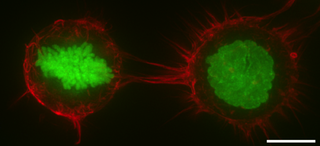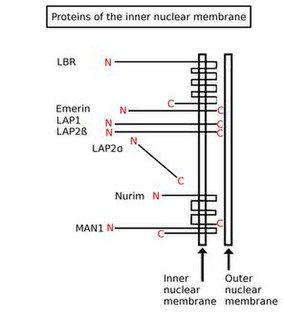
The cell is the basic structural, functional, and biological unit of all known living organisms. A cell is the smallest unit of life. Cells are often called the "building blocks of life". The study of cells is called cell biology or cellular biology.

In cell biology, the cytoplasm is all of the material within a cell, enclosed by the cell membrane, except for the cell nucleus. The material inside the nucleus and contained within the nuclear membrane is termed the nucleoplasm. The main components of the cytoplasm are cytosol – a gel-like substance, the organelles – the cell's internal sub-structures, and various cytoplasmic inclusions. The cytoplasm is about 80% water and usually colorless.

Microtubules are polymers of tubulin that form part of the cytoskeleton and provide structure and shape to the cytoplasm of eukaryotic cells, some bacteria and some archaea. A microtubule can grow as long as 50 micrometres and are highly dynamic. The outer diameter of a microtubule is about 24 nm while the inner diameter is about 12 nm. They are formed by the polymerization of a dimer of two globular proteins, alpha and beta tubulin into protofilaments that can then associate laterally to form a hollow tube, the microtubule. The most common form of a microtubule consists of 13 protofilaments in the tubular arrangement.

A cytoskeleton is present in the cytoplasm of all cells, including bacteria, and archaea. It is a complex, dynamic network of interlinking protein filaments that extends from the cell nucleus to the cell membrane. The cytoskeletal systems of different organisms are composed of similar proteins. In eukaryotes, the cytoskeletal matrix is a dynamic structure composed of three main proteins, which are capable of rapid growth or disassembly dependent on the cell's requirements.

Actin is a family of globular multi-functional proteins that form microfilaments. It is found in essentially all eukaryotic cells, where it may be present at a concentration of over 100 μM; its mass is roughly 42-kDa, with a diameter of 4 to 7 nm.

Nuclear lamins, also known as Class V intermediate filaments, are fibrous proteins providing structural function and transcriptional regulation in the cell nucleus. Nuclear lamins interact with membrane-associated proteins to form the nuclear lamina on the interior of the nuclear envelope. Lamins are present in all members of the kingdom Animalia (Metazoa), but are not found in unicellular organisms, plants, or fungi. Lamin proteins are involved in the disassembling and reforming of the nuclear envelope during mitosis, the positioning of nuclear pores, and programmed cell death. Mutations in lamin genes can result in laminopathies, some of which are potentially lethal disorders.
A nuclear localization signalorsequence (NLS) is an amino acid sequence that 'tags' a protein for import into the cell nucleus by nuclear transport. Typically, this signal consists of one or more short sequences of positively charged lysines or arginines exposed on the protein surface. Different nuclear localized proteins may share the same NLS. An NLS has the opposite function of a nuclear export signal (NES), which targets proteins out of the nucleus.

The cell cortex, also known as the actin cortex or actomyosin cortex, is a specialized layer of cytoplasmic proteins on the inner face of the cell membrane. It functions as a modulator of membrane behavior and cell surface properties. In most eukaryotic cells lacking a cell wall, the cortex is an actin-rich network consisting of F-actin filaments, myosin motors, and actin-binding proteins. The actomyosin cortex is attached to the cell membrane via membrane-anchoring proteins called ERM proteins and it plays a central role in cell shape control. The protein constituents of the cortex undergo rapid turnover, making the cortex both mechanically rigid and highly plastic, two properties essential to its function. In most cases, the cortex is in the range of 100 to 1000 nanometers thick.
KASH domains are conserved C-terminal protein regions less than ~30 amino acids. KASH is an acronym for Klarsicht, ANC-1, Syne Homology. KASH domains always follow a transmembrane domain. Most proteins containing KASH domains are thought to be involved in the positioning of the nucleus in the cell. KASH domains interact with proteins containing SUN domains in the space between the outer and inner nuclear membranes to bridge the nuclear envelope, and may transfer force from the nucleoskeleton to the cytoplasmic cytoskeleton and enable mechanosensory roles in cells. KASH proteins are thought to largely localize to the outer nuclear membrane, although there are reports of inner nuclear membrane localization of some KASH protein isoforms.
SUNdomains are conserved C-terminal protein regions a few hundred amino acids long. SUN domains are usually found following a transmembrane domain and a less conserved region of amino acids. Most proteins containing SUN domains are thought to be involved in the positioning of the nucleus in the cell. It is thought that SUN domains interact directly with KASH domains in the space between the outer and inner nuclear membranes to bridge the nuclear envelope and transfer force from the nucleoskeleton to the cytoplasmic cytoskeleton which enables mechanosensory roles in cells. SUN proteins are thought to localize to the inner nuclear membrane. The S. pombe Sad1 protein localises at the spindle pole body. In mammals, the SUN domain is present in two proteins, Sun1 and Sun2. The SUN domain of Sun2 has been demonstrated to be in the periplasm.

The nuclear envelope, also known as the nuclear membrane, is made up of two lipid bilayer membranes which in eukaryotic cells surrounds the nucleus, which encases the genetic material.

Nucleoporins are a family of proteins which are the constituent building blocks of the nuclear pore complex (NPC). The nuclear pore complex is a massive structure embedded in the nuclear envelope at sites where the inner and outer nuclear membranes fuse, forming a gateway that regulates the flow of macromolecules between the cell nucleus and the cytoplasm. Nuclear pores enable the passive and facilitated transport of molecules across the nuclear envelope. Nucleoporins, a family of around 30 proteins, are the main components of the nuclear pore complex in eukaryotic cells. Nucleoporin 62 is the most abundant member of this family. Nucleoporins are able to transport molecules across the nuclear envelope at a very high rate. A single NPC is able to transport 60,000 protein molecules across the nuclear envelope every minute.

Dynactin is a 23 subunit protein complex that acts as a co-factor for the microtubule motor cytoplasmic dynein-1. It is built around a short filament of actin related protein-1 (Arp1).

Alpha-centractin (yeast) or ARP1 is a protein that in humans is encoded by the ACTR1A gene.

Nesprin-2 is a protein that in humans is encoded by the SYNE2 gene. The human SYNE2 gene consists of 116 exons and encodes nesprin-2, a member of the nuclear envelope (NE) spectrin-repeat (nesprin) family. Nesprins are modular proteins with a central extended spectrin-repeat (SR) rod domain and a C-terminal Klarsicht/ANC-1/Syne homology (KASH) transmembrane domain, which acts as a NE-targeting motif. Nesprin-2 (Nesp2) binds to cytoplasmic F-actin, tethering the nucleus to the cytoskeleton and maintaining the structural integrity of the nucleus.

Stress fibers are contractile actin bundles found in non-muscle cells. They are composed of actin (microfilaments) and non-muscle myosin II (NMMII), and also contain various crosslinking proteins, such as α-actinin, to form a highly regulated actomyosin structure within non-muscle cells. Stress fibers have been shown to play an important role in cellular contractility, providing force for a number of functions such as cell adhesion, migration and morphogenesis.
Nesprins (nuclear envelope spectrin repeat proteins are a family of proteins that are found primarily in the outer nuclear membrane, as well as other subcellular compartments. They contain a C-terminal KASH transmembrane domain and are part of the LINC complex which is a protein network that associates the nuclear envelope to the cytoskeleton, outside the nucleus, and the nuclear lamina, inside the nucleus. Nesprin-1 and -2 bind to the actin filaments. Using FRAP and FCCS, it has been shown that there is a dynamic connection between nesprin-2 and actin. Nesprin-3 binds to plectin, which is bound to the intermediate filaments, while nesprin-4 interacts with kinesin-1.

Inner nuclear membrane (INM) proteins are proteins that are embedded in or associated with the inner membrane of the nuclear envelope (NE). There are about 60 INM proteins, most of which are poorly characterized with respect to structure and function. Among the few well-characterized INM proteins are lamin B receptor (LBR), lamina-associated polypeptide 1 (LAP1), lamina-associated polypeptide-2 (LAP2), emerin and MAN1.
Cell mechanics is a sub-field of biophysics that focuses on the mechanical properties and behavior of living cells and how it relates to cell function. It encompasses aspects of cell biophysics, biomechanics, soft matter physics and rheology, mechanobiology and cell biology.














